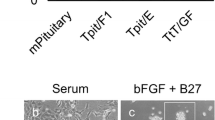Abstract
The IM-9-P cell line is a variant of the human B-lymphoblastoid cell line IM-9 which ectopically secretes prolactin (hPRL). The heterogeneous line IM-9-P and three sublines of clonal origin, two of them positive and one negative for PRL gene expression, were subjected to cytogenetic analysis and compared with the reference line IM-9 which showed a normal female diploid karyotype. G-banding revealed several rearrangements in the chromosomes. Nine altered chromosomes including one stable marker chromosome were common to all analysed karyotypes of IM-9-P cells and their clones. A second marker chromosome ‘mar2’ occurred only in the karyotypes of the hPRL producing clones, but not in the non-producing clone. None of the visible alterations involve chromosome 6 which carries the PRL gene in humans.
Similar content being viewed by others
References
American Type Culture Collection Catalogue of cell lines and hybridomas, 5th edition (1985) Hay R, Macy M, Corman-Weinblatt A, Chen TR and McClintock P (ed.) ATCC, Rockville, Maryland.
Brøgger A (1982) The chromatid gap—a useful parameter in genotoxicology? Cytogenet. Cell Genet. 33: 14–19.
Caspersson T, Zech L, Johansson C and Modest EJ (1970) Identification of human chromosomes by DNA-binding fluorescent agents. Chromosoma 30: 215–227.
Chen TR, Hay RJ and Macy ML (1982) Karyotype consistency in human colorectal carcinoma cell lines established in vitro. Cancer Genet. Cytogenet. 6: 93–117.
Croce CM (1987) Role of chromosome translocations in human neoplasia. Cell 49: 155–156.
Croce CM and Nowell PC (1985) Molecular basis of human B cell neoplasia. Blood 65: 1–7.
Croce CM, Tsujimoto Y, Erikson J and Nowell P (1984) Biology of disease-Chromosome translocations and B cell neoplasia. Lab. Invest. 51: 258–267.
DiMattia GE, Gellersen B, Bohnet HG and Friesen HG (1988) A human B-lymphoblastoid cell line produces prolactin. Endocrinology 122: 2508–2517.
Emanuel BS, Selden JR, Chaganti RSK, Jhanwar S, Nowell PC and Croce CM (1984) The 2p breakpoint of a 2;8 translocation in Burkitt lymphoma interrupts the Vk locus. Proc. Natl. Acad. Sci. USA 81: 2444–2446.
Evans HJ and O'Riordan ML (1975) Human peripheral blood lymphocytes for the analysis of chromosome aberrations in mutagen tests. Mutat. Res. 31: 135–148.
Fahey JL, Buell DN and Sox HC (1971) Proliferation and differentiation of lymphoid cells: studies with human lymphoid cell lines and immunoglobulin synthesis. Ann. N.Y. Acad. Sci. 190: 221–234.
Gebhart E (1988) What can the data of modern tumor cytogenetics teach us for mutagenicity testing? GUM 2: 2–8.
Gellersen B, DiMattia G, Kempf R and Bohnet HG (1989) Ectopically produced prolactin-an autocrine growth factor? Acta Endocrinologica 120 (Suppl. 1): 222.
ISCN (1985) An international system for human cytogenetic nomenclature, 1985, Karger, Basel.
Nilsson K and Klein G (1982) Phenotypic and cytogenetic characteristics of human B-lymphoid cell lines and their relevance for the etiology of Burkitt's lymphoma. Advances in Cancer Research 37: 319–380.
Oken MM (1984) Multiple myeloma. Medical Clinics of North America 68: 757–787.
Owerbach D, Rutter WJ, Cooke NE, Martial JA and Shows TB (1981) The prolactin gene is located on chromosome 6 in humans. Science 212: 815–816.
Pathak S (1986) Constitutional translocations and predisposition to T- and B-cell malignancies. Cytogenet. Cell Genet. 43: 223–225.
Philip P (1975) Marker chromosome 14q+ in multiple myeloma. Hereditas 80: 155–156.
Philip P and Drivsholm AA (1976) G-banding analysis of complex aneuploidy in multiple myeloma bone marrow cells. Blood 47: 69–77.
Rowley JD (1980) Chromosome abnormalities in human leukemia. Ann. Rev. Genet. 14: 17–39.
Seabright M (1971) A rapid banding technique for huma chromosomes. The Lancet 2: 971–972.
Sumner AT (1972) A simple technique for demonstrating centromeric heterochromatin. Expl. Cell. Res. 75: 304–306.
Van den Berghe H, Vermaelen K, Louwagie A, Criel A, Mecucci C and Vaerman J-P (1984) High incidence of chromosome abnormalities in IgG3 myeloma. Cancer Genet. Cytogenet. 11: 381–387.
Yunis JJ (1983) The chromosomal basis of human neoplasia. Science 221: 227–236.
Author information
Authors and Affiliations
Rights and permissions
About this article
Cite this article
Bonhoff, A., Gellersen, B., Held, K.R. et al. Clonal derivatives of a human B-lymphoblastoid cell line producing prolactin—A cytogenetic characterization. Cytotechnology 3, 43–50 (1990). https://doi.org/10.1007/BF00365265
Received:
Accepted:
Issue Date:
DOI: https://doi.org/10.1007/BF00365265




